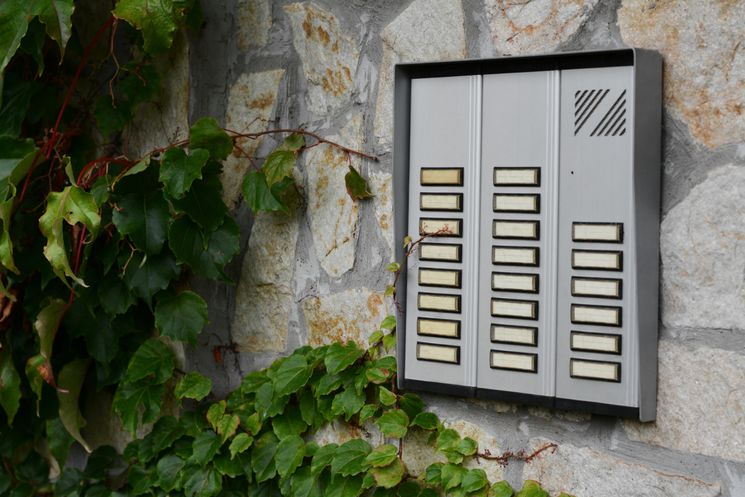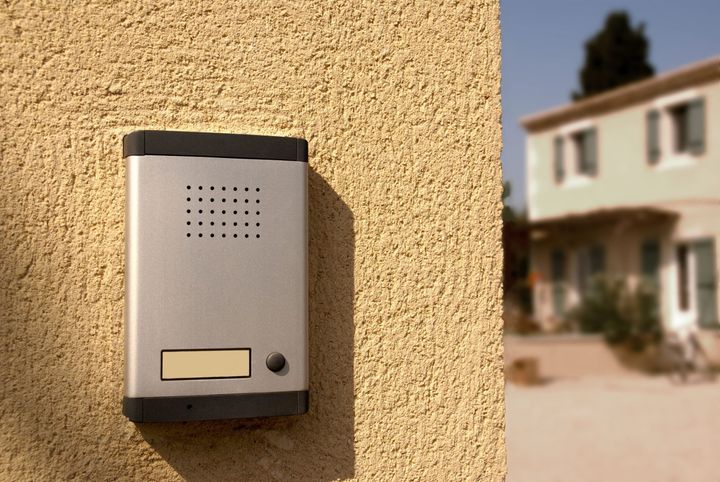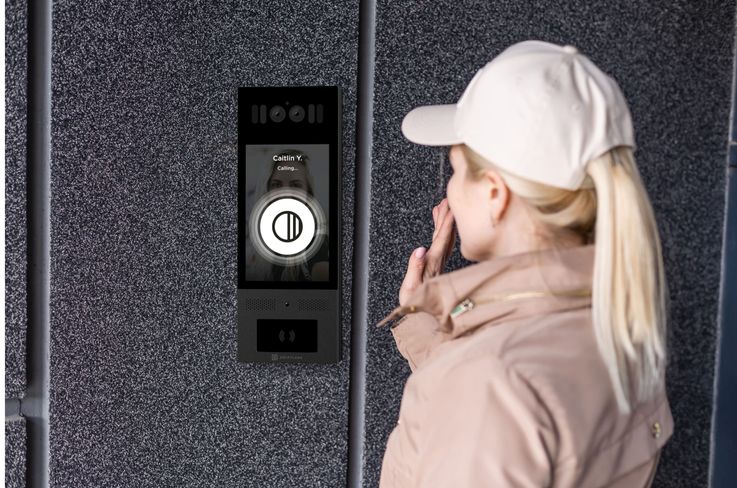Table of contents
- What is a Wireless Commercial Intercom System
- What is a Commercial Video Intercom System
- Benefits of a Commercial Video Intercom System
- How a Wireless Video Intercom Works
- Types of Wireless Commercial Intercom Systems
- Comparison of Best Wireless Commercial Intercom Systems
- Benefits of a Wireless Commercial Intercom for Reducing Upfront and Ongoing Costs
- Benefits of a Wireless Intercoms in an Office or Commercial Building
Also, read
- Best Video Intercom Systems
- Guide to Apartment Intercom System
- How to Buy a Wireless Intercom System
- Buying an Apartment Intercom System with Door Release
As the world becomes more connected, businesses are constantly searching for ways to streamline their operations and provide a better experience for their customers and employees. One area where this is particularly important is access control, which encompasses everything from building entry to package delivery to guest management. That’s where the commercial applications of wireless intercom systems come in. A wireless intercom system can provide a reliable and convenient way to manage access to a building, without the need for complicated wiring or expensive hardware. But with so many options in the market, how do you know which system is right for your business?
In this blog post, we’ll explore the key considerations to keep in mind when purchasing a commercial wireless intercom system, including the types of systems available, the features and benefits to look for, and the factors that can affect installation and ongoing costs. Whether you’re a small business owner or a facilities manager for a large commercial property, this guide will help you navigate the complex landscape of wireless intercom systems and find the right solution for your needs.
Suggested Posts:
Commercial Intercom Systems: 30 Buyer Considerations
What is a Wireless Commercial Intercom System
Wireless commercial intercoms are a type of intercom system that uses wireless technology to transmit audio and video signals between a door station and a receiver. These systems are typically easier and less expensive to install than wired systems because they do not require cables to be run throughout the building. Wireless intercoms can also be more scalable, as additional receivers can easily be added to the system as needed. They also offer greater flexibility in terms of where calls can be received, as they can be routed to any device with internet or cellular connectivity. Some wireless intercoms even offer biometric access or integration with key fobs or key cards for added security. However, the reliability of a wireless system is dependent on the strength and stability of the internet or cellular connection, which can be a potential drawback.
What is a Commercial Video Intercom System
A commercial video intercom system is a type of intercom system that allows for video communication between a visitor and a remote employee, as well as the ability to unlock doors remotely. Calls can be received on a mobile app or through a web browser, allowing for remote access to the intercom system even when not physically present. One of the key benefits of video intercoms is added security, as employees can visually confirm the identity of the visitor before granting access. They also provide an audit trail of visitors, helping to improve building security and track access. Video intercoms can work with existing internet or cellular connections, reducing the need for costly telephone line systems. Many video intercom systems also offer modern access methods, such as mobile app or face recognition access, improving convenience and efficiency for employees.
Benefits of a Commercial Video Intercom System
- Commercial video intercom systems allow for visual communication between a visitor and a remote employee, with the ability to unlock doors remotely.
- Calls can be received on a mobile app or through a web browser, allowing for remote access to the intercom system even when not physically present.
- Video intercoms provide added security by allowing employees to visually confirm the identity of the visitor before granting access.
- They also provide an audit trail of visitors, helping to improve building security and track access.
- Video intercoms can work with existing internet or cellular connections, reducing the need for costly telephone line systems.
- Many video intercom systems also offer modern access methods, such as mobile app or face recognition access, improving convenience and efficiency for employees.
How a Wireless Video Intercom Works
A wireless video intercom system works by using a camera to capture video of a visitor outside a an office building, and transmitting that video signal wirelessly to a receiver inside the building. The receiver can be a standalone unit or can be integrated with existing devices like smartphones, tablets, or computers. When a call is received, the receiver will display the video feed and allow the person inside to communicate with the visitor using a microphone and speaker. If the visitor needs to be let inside, the receiver can be used to trigger an electric door lock mechanism, which can be integrated with the intercom system. The door lock mechanism can be either an electric strike, an electric latch, or a magnetic lock, and will unlock the door when triggered by the intercom system. This allows the person inside to remotely unlock the door for the visitor without having to physically go to the door to do so. Overall, a wireless video intercom system provides an easy-to-use and secure way for businesses to manage access to their building.
Types of Wireless Commercial Intercom Systems
Audio Intercoms
Audio intercoms are the simplest type of wireless intercom system, allowing for two-way audio communication between a call station at the entrance of a building and a receiver inside. They are typically less expensive and easier to install than more advanced systems, but they offer limited functionality and may not be ideal for larger or more complex buildings.
Video Intercoms
Video intercoms are a more advanced type of wireless intercom system that allows for both audio and video communication between a call station and a receiver inside. They may also include additional features such as facial recognition, remote access, and integration with other security systems. Video intercoms are ideal for larger commercial buildings or those with higher security needs, as they provide a visual verification of visitors before granting access.
Telephone Line Intercoms
Telephone line intercoms are a type of audio intercom system that use a building’s existing telephone lines to communicate between a call station and a receiver inside. These systems are typically less expensive than other wireless office intercoms or systems and can be useful for small or simple buildings.
Mobile Phone-Based Intercoms
Mobile phone-based intercoms use an app that allows the building owners or occupants to receive calls and grant access using their smartphones. These systems are similar to smartphone-enabled intercoms but may use different technology or offer different features.
Point-to-Point Intercoms
Point-to-point intercoms allow communication between two specific points, such as between two rooms or buildings. These two way communication systems are typically used in smaller buildings or in situations where only limited communication is necessary.
Visitor Intercoms
Visitor intercoms are designed specifically for managing visitor access. These systems may include features such as video verification, remote access control, and integration with visitor management software.
Broadcasting Intercoms
Broadcasting intercoms allow for one-way communication, such as announcements or alerts. These systems may be used in settings such as schools, hospitals, commercial properties, or industrial facilities to relay important information to building occupants.
When considering the different types of commercial wireless intercom systems available, it’s important to evaluate the specific needs and requirements of your building. Factors such as the size of the building, the number of occupants, and the desired level of security and access control will all play a role in determining which commercial intercom system work together is the best fit. By working with a knowledgeable provider and carefully evaluating your options, you can find a wireless intercom system that meets your needs and provides a reliable and convenient solution for managing building access.
When purchasing a wireless commercial intercom system, there are several key factors to consider. Here are some things to look for:
1. Device Compatibility
Check if the system allows you to receive a call on any type of device, or wireless connection such as a phone, tablet, or computer, to ensure convenience and accessibility.
2. Audio and Video Calling
Make sure the system can receive both video calls through a mobile app and regular telephone calls to provide flexibility in how visitors can contact you.
3. Scheduled Calls
Consider whether the intercom system allows you to schedule calls during certain windows of time to avoid interruptions during important meetings or events.
4. Multi-Person Routing
Choose a system that can route calls to multiple people in case the primary person is unavailable or busy, ensuring that visitors can always get in touch with someone.
5. Live Snapshot at the Door
Check if the system allows you to get a live snapshot of the visitor at the door, providing an added layer of security and identification.
6. Reverse Callback
Consider whether the system allows you to initiate a reverse callback from your phone back to the intercom system, allowing you to easily communicate with visitors.
7. Integration with Door Lock Mechanisms
Look for a system that can connect to your office’s door lock door release mechanism now, allowing you to lock and unlock doors with ease.
8. Receiver Options
Choose a system that provides receiver options that meet your specific needs, whether that be a master station, base station, or standard devices.
9. Vandal Protection and Weather Resistance
Check if the intercom system is rated for weather and temperature extremes and if it has built-in vandal protection, ensuring that it can withstand various environmental conditions.
By considering these features and working with a reliable provider, you can find a wireless commercial intercom system that meets your needs and provides multiple tenants with a convenient and secure solution for their security teams managing building access.
10. Customizable Directory
Look for a system that allows you to customize the directory display with options like full names, business names, or unit numbers, ensuring that visitors can easily identify who they need to contact.
11. Remote Management
Consider whether the system allows for remote management, allowing you to request access and make changes and updates from anywhere.
12. Mobile App Access
Choose a system that provides mobile app access to the intercom system, allowing you to manage and monitor access from your smartphone.
13. Biometric Access
Check if the property access system provides biometric access options like face recognition, providing an added layer of security for building access.
14. Key Fob and Key Card Support
Look for a system that supports key fobs and key cards, allowing you to integrate the intercom system with your existing access control system.
15. Ongoing Costs
Consider the ongoing costs of the system, such as maintenance contracts and software licenses, to ensure that you can afford to maintain the system over time.
By taking into account these additional features, you can make a more informed decision when purchasing a wireless commercial intercom system that best fits your needs.
Comparison of Best Wireless Commercial Intercom Systems
When comparing various wireless commercial intercom systems, it is important to consider several factors such as device compatibility, audio and video calling, scheduled calls, multi-person routing, live snapshots at the door, reverse callback, integration with door lock mechanisms, receiver options, vandal protection and weather resistance, customizable directory, remote access permissions and management, mobile app access, biometric access, key fob and key card support, and ongoing costs.
However, it can be overwhelming to evaluate all of these factors for each potential intercom system. That is why Swiftlane has created a comprehensive guide to buying intercom systems for offices, which goes into even greater detail about how to compare different systems and what to look for in each feature.
The Ultimate Guide to Buying Intercom Systems for Offices covers everything from wired and wireless intercom systems to specific considerations for different types of office buildings, to installation and maintenance tips. It even includes a handy checklist for evaluating potential intercom systems.
If you are in the market for a wireless commercial intercom system, we highly recommend checking out this guide for a more in-depth look at what to consider when purchasing an intercom system for your office. Click here to gain access to the full guide:
Best Business and Office Intercoms
Benefits of a Wireless Commercial Intercom for Reducing Upfront and Ongoing Costs
Wireless commercial intercom systems offer numerous benefits for reducing upfront and ongoing costs. First, they can help reduce installation costs by eliminating the need to run wires throughout the entire building for the receiving station. Instead, only the front intercom needs to be wired, which can result in significant cost savings. Additionally, businesses can save money by reusing existing devices, such as phones or computers, to receive intercom calls, instead of purchasing additional receiver tablets or master intercom stations themselves. This can reduce the cost of hardware and eliminate the need for additional equipment, further reducing installation costs. Finally, wireless intercom systems can receive calls through any Wi-Fi or Internet connection, eliminating the need for expensive telephone lines or calling systems. Overall, a wireless commercial intercom system can offer a cost-effective solution for businesses that want to improve communication and security without breaking the bank.
Mobile app based interface
One of the major benefits of wireless commercial intercom systems is that they can work seamlessly with mobile apps, allowing employees to receive calls and communicate with visitors from their smartphones or tablets. With the use of a mobile app, employees can easily view who is at the door and grant access remotely without having to physically go to the front desk or door. This can save time and increase efficiency, especially in larger buildings or those with high visitor traffic. Additionally, mobile apps can also provide additional features such as scheduling calls during specific times or days, setting up automatic call forwarding, or even providing biometric access through facial recognition or fingerprint scanning. Overall, wireless commercial intercom systems that work with mobile apps can offer a convenient and efficient way for businesses to manage their own access control systems and improve communication with visitors.
Benefits of a Wireless Intercoms in an Office or Commercial Building
Here are some key benefits of having an intercom system in a commercial building:
- Keeps doors closed and secure: Intercom systems allow businesses to keep their doors closed and secure, only allowing authorized personnel to enter with a key card or other access control measures.
- Improves efficiency: With an intercom system, front desk personnel can efficiently manage visitors and handle calls without having to physically escort them to their destination.
- Increases safety: Intercom systems allow for quick communication and identification of visitors, which can improve building security and reduce the risk of unauthorized access or security breaches.
- Enhances communication: With the ability to communicate with visitors and employees through an intercom system, businesses can improve communication and reduce misunderstandings or miscommunications.
- Enables remote management: Some intercom systems allow for remote management, allowing employees to manage access control and communicate with visitors from their smartphones or other mobile devices.
- Saves time and money: By reducing the need for front desk personnel to physically escort visitors, intercom systems can save businesses time and money on labor costs.
- Provides a professional image: A modern and efficient intercom system can give a professional impression to visitors and enhance the overall image of the business.
Conclusion
In summary, a wireless commercial intercom system can greatly enhance communication between employees and visitors in a business or organization. When choosing a wireless intercom system, it is important to consider factors that were presented to you in this post, in order to ensure you are choosing the most suited intercom system for your business. It is important to first determine the specific needs of your organization and choose a system that best meets those. Keeping these 15 things in mind, when selecting a wireless commercial intercom system, will ensure that you pick the best solution for your business. If you would like a free consultation on upgrading to a wireless commercial intercom system, contact Swiftlane and you’ll be sure to be in good hands.
Start Improving Your Building Security
Get in touch with a Swiftlane specialist for more information on the best access control and video intercom solution for your building.












